Benign Paroxysmal Positional Vertigo (BPPV). It is one of the most common causes of vertigo. It is characterized by brief intense spells of rotatory vertigo which usually precipitates during an abrupt change in head position. Vertigo occurs when the patient is getting out of bed, turning over in bed and when extending or flexing the neck. BPPV is predominated in females (2:1 female to male ratio).
Aetiology. Mostly it is idiopathic, and the incidence increases with advancing age. Known causes of BPPV are head trauma, ear infection, viral labyrinthitis, stapedectomy, prolonged bed rest, vestibular neuritis and Meniere’s disease. Dislodgement of otoconial debris from the utricle is the common feature in all of these causes.
Pathophysiology. Otoconia are crystals of calcium carbonate present on the macula of the utricle and saccule. In BPPV otoconial debris dislodges from degenerating macula of the utricle and floats freely in the semicircular canals (canalolithiasis). Otoconia most commonly enters in the posterior semicircular canal as compared to horizontal and anterior canals. Since otoconia have three times greater density than that of the endolymph, the cupula becomes sensitive to gravity. When otoconial debris sticks on the cupula of the posterior semicircular canal (cupulolithiasis) in a critical head position with respect to gravity, it results in an abnormal displacement of the cupula and stimulation of the corresponding vestibular afferents. This causes nystagmus and vertigo.
Posterior canal is more commonly involved because:
- Size of the opening common crus of the posterior and anterior (superior) semi-circular canals
- As its anatomical location makes it the most dependent position in both erect and supine, particles get trapped in this canal.
- Particles also get trapped due to posterior canal opening is uppermost in the upright position.
- Particles move more backwards and forwards during rolling over in bed.
Hence, its position does not allow natural clearance of particles back to utricle.
Symptoms. Episode of vertigo typically begins with a latent period-up to 2-20 sec with or without nausea and usually lasts less than a minute. Spells of vertigo are multiple, occurs in clusters and are associated with change in head position. In between the episodes, patient are either symptom-free or may have marked unsteadiness (patient have a feeling of walking on pillows). There is no associated hearing loss, tinnitus, aural fullness or other neurologic symptoms.
Diagnosis. Though the typical history itself establishes the diagnosis. The properties of the nystagmus during hallpike maneuver helps in making diagnosis of BPPV and also rules out positional vertigo of central origin.
The properties of nystagmus in BPPV are:
- Latency – 2–20 s (delay in onset is due to time taken by the mass of otoconial debris to be displaced because of inertia)
- Direction – Fixed, towards the under most ear
- Duration – Less than 1 min
- Fatiguable (with repeated movements the otoconial debris may get dispersed or may get trapped in some part of the canal)
| Features of BPPV type | p-BPPV | h-BPPV | a-BPPV |
| Diagnostic test | Dix-Hallpike | Supine roll | Dix-Hallpike |
| Nystagmus type | Mixed torsional/upbeating | Horizontal | Mixed torsional/downbeating |
| Nystagmus direction | Geotropic | Mainly geotropic and occasionally apogeotropic | Either geotropic or apogeotropic |
| Treatment | Epley’s manoeuvreSemont’s manoeuvre | Forced prolonged position, Barbecue. | Modified Epley’s manoeuvre |
However, there are specific positional tests, the resultant nystagmus of these tests indicates which semicircular canal is involved in BPPV.
The specific positional tests to diagnose the canal involved are:
(i) Dix–Hallpike positional test.
Both posterior and anterior canal gets stimulated on the Dix–Hallpike positional test. The Left Anterior and Right Posterior canals are stimulated during the right side Dix–Hallpike manoeuvre and vice versa. On performing right side Dix–Hallpike there is ampullofugal (excitatory) flow in the right posterior canal and ampullopetal (inhibitory) flow in the left anterior.
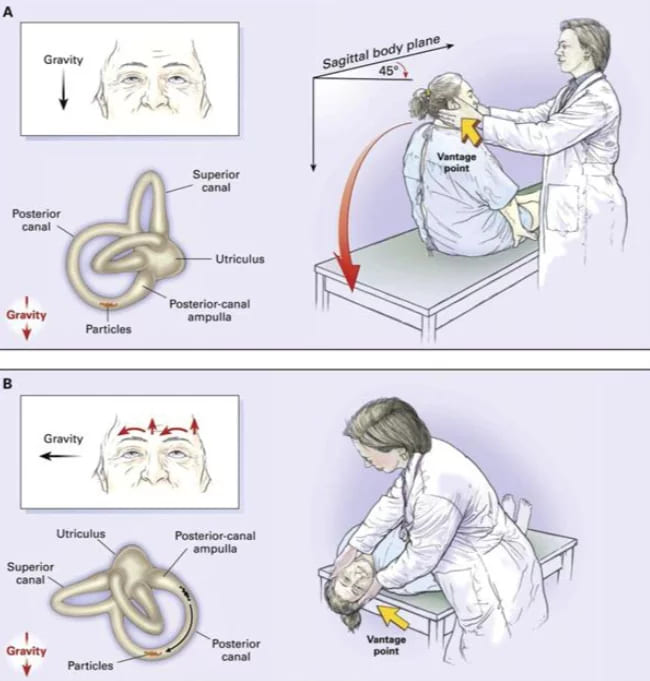
Interpretation.
- Otoconial debris in the posterior semicircular canal – The direction of nystagmus is upwards and outwards-torsional in the right eye. (vertical-up beating torsional nystagmus)
- Otoconial debris in the anterior semicircular canal – The direction of nystagmus is downwards and intorsional in the left eye. (vertical-down beating torsional nystagmus)
(ii) Supine head roll test
This test is used to diagnose horizontal canal BPV. Involvement of the horizontal canal should be suspected if during the Hallpike test patient is having nystagmus on both right and left side.
Steps of Roll test
For this manoeuvre, the patient lies down on the couch with his head held up in central position by the clinician at a 30-degree angle or raise the head end of the couch by 300degrees. Turn the patient’s head 90° to one side. Then the head is brought back to the normal central position. Now, turn the patient’s head 90° to the opposite side. After each step wait for 30 seconds or till vertigo and nystagmus subside.
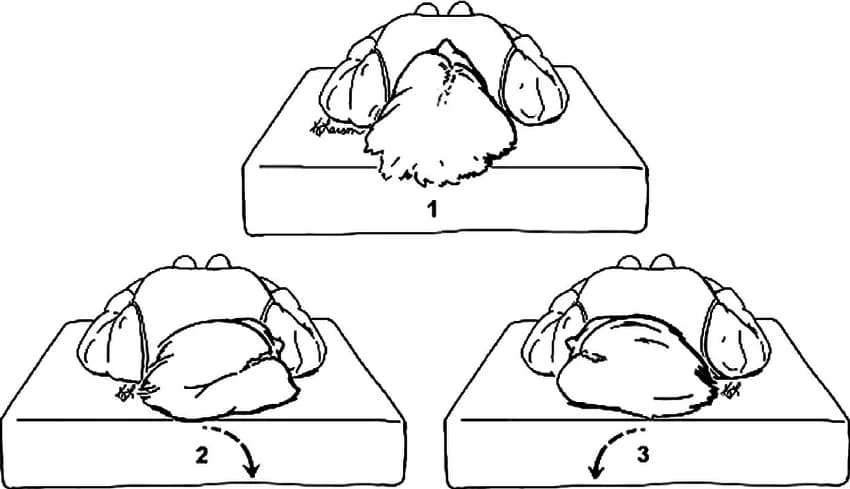
Interpretation.
If the horizontal canal is involved both sides will produce symptoms and a horizontal nystagmus beating toward the earth (geotropic). The side (right or left) which is involved will have more stronger nystagmus and will be more symptomatic.
Management. Treatment is usually non-surgical and consists of canal repositioning manoeuvres. The principle of each manoeuvre is to relocate the otoconial debris from the semicircular canal back into the utricle.
Repositioning maneuvers for Posterior semicircular canal.
(i) Epley’s manoeuvre.
Sequence of positions are:
- The patient is made to sit on the couch with face away from the examiner and brought down in lying down position with the head turned by 45 degrees to the affected side and extended over the edge of the table, same as Dix–Hallpike manoeuvre.
- Then the head is turned 90 degrees to the opposite side until it’s facing 45 degrees to unaffected side and with the affected ear up.
- The head is then rotated a further 90 degrees. Head and body both turned as a unit to the unaffected side so that face is turned to the ground.
- Now brought the patient to the sitting position with the head turned 45 degrees to the unaffected side.
- In the last step, the head turned forward and chin brought down 200.
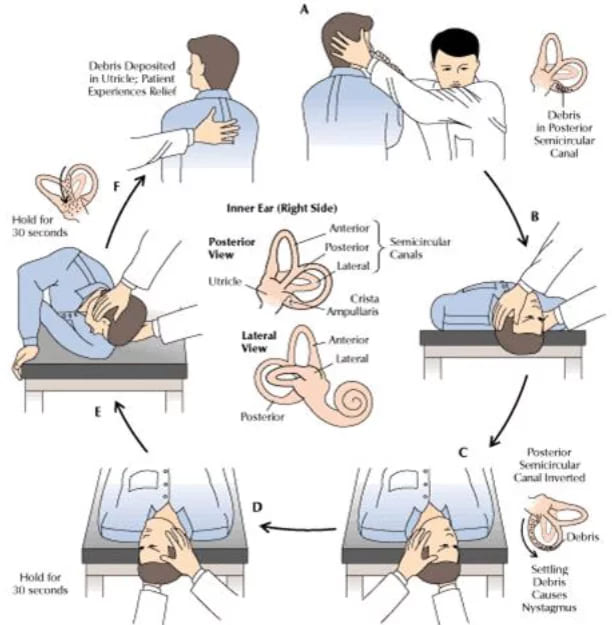
After each step wait for 30 seconds or till vertigo and nystagmus subside. Epley manoeuvre can be repeated until there is no nystagmus or there is no further improvement in last two manoeuvres. After the treatment, The patient is advised to avoid vertical head movements for the next 48 hours as it may again dislodge the otoconia. Upright posture is advised for the next 48 h. Total resolution of symptoms is seen in 80-90% of patients. Sometimes a bone vibrator is placed on the mastoid bone, which helps to loosen the debris.
(ii) Semont’s liberatory manoeuvre.
It is more effective but difficult for the patient to tolerate. The patient is rapidly turned into various positions to dislodge the debris from the cupula. The sequence of positions for right posterior SCC are: The patient is made to sit on the edge of the couch with the face turned 45° to the left side and is quickly moved from sitting to side-lying position on the right side and remain in this position for 1 min. Then the patient is rapidly turned 180 degrees to the left side such that the position of the left ear is facing downwards and remain in this position for 1 min. The original orientation of the head should not be changed during each step. Now the patient is brought up slowly to sitting upright position on the edge of the couch and maintain the head level for 10 minutes.
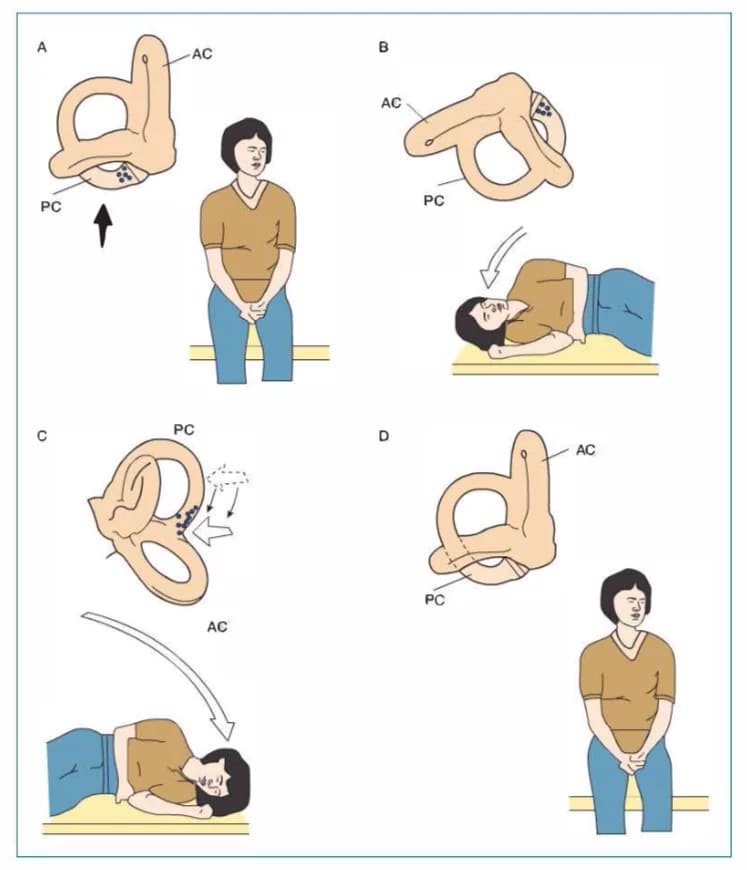
Alleviation of symptoms is reported in 90-92% of patients treated once or several times with this manoeuvre.
(iii) Brandt–daroff positional exercises
The sequence of positions: The patient is made to sit on the edge of the couch and is quickly moved from sitting to side-lying position on the affected side (nose 45 degrees up). Then the patient comes back to the original sitting position. Then the patient is moved from sitting to side-lying position on the unaffected side (nose 45 degrees up) and then again comes back to the original sitting position. After each position, the patient will remain in that position for at least 30 seconds or until vertigo subsides. The entire sequence is repeated 5 times and is performed 3 times a day.
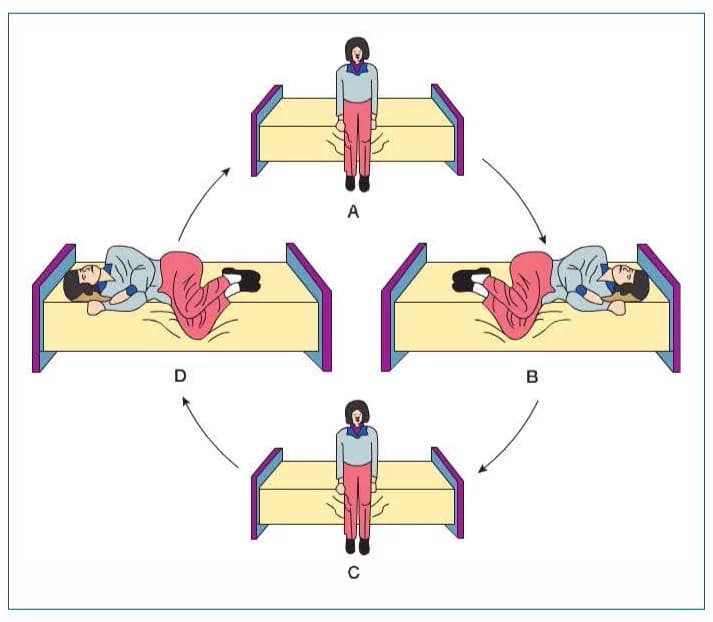
Alleviation of symptoms is reported in 90-98% of patients. But sometimes it may produce self-induced vertigo attacks. That is why it is no longer the first choice of treatment.
Surgical treatment of p-BPPV. Indicated in patients who do not respond to repositioning manoeuvres.
- Posterior canal occlusion
- Singular neurectomy
Repositioning manoeuvres for horizontal semicircular canal.
(i) Forced prolonged position
The patient is advised to lie down on the unaffected side with the affected ear up for 12 hours. It will make the affected h-SCC uppermost and help debris to relocate back into the vestibule due to gravity.
(ii) 270-degree ‘barbecue’ manoeuvre
For this manoeuvre, the patient lies down on the couch with his head held up in central position by the clinician at a 30-degree angle, or raise the head end of the couch by 300degrees. Turn the patient’s head 90° to the affected side. Then the head is brought back to the normal central position. In next step patient’s head is turned 90° to the unaffected side. Now, the patient’s head is even further turned 90° along with the whole body as a unit, such that the body will eventually assume the prone position. In the last step, the patient is brought slowly up to normal upright position. After each step wait for 30–60 seconds or till vertigo and nystagmus subside.
Repositioning manoeuvres for anterior semicircular canal.
(i) Modified Epley’s manoeuvre
During Dix– Hallpike when the head is turned 45 degrees away from the affected ear, keep the patient in this position for 30 seconds then elevating the head at 45 degrees for 1 minute while maintaining a supine position. Now brought the patient to the sitting position with the chin bent forwards at 30 degrees.
———— End of the chapter ————
Learning resources.
- Scott-Brown, Textbook of Otorhinolaryngology Head and Neck Surgery.
- Glasscock-Shambaugh, Textbook of Surgery of the Ear.
- Logan Turner, Textbook of Diseases of The Nose, Throat and Ear Head And Neck Surgery.
- Rob and smith, Textbook of Operative surgery.
- P L Dhingra, Textbook of Diseases of Ear, Nose and Throat.
- Hazarika P, Textbook of Ear Nose Throat And Head Neck Surgery Clinical Practical.
- Mohan Bansal, Textbook of Diseases of Ear, Nose and Throat Head and Neck surgery.
- Anirban Biswas, Textbook of Clinical Audio-vestibulometry.
- W. Arnold, U. Ganzer, Textbook of Otorhinolaryngology, Head and Neck Surgery.
- Salah Mansour, Textbook of Comprehensive and Clinical Anatomy of the Middle Ear.
- Susan Standring, Gray’s Anatomy.
- Ganong’s Review of Medical Physiology.
Author:

Dr. Rahul Kumar Bagla
MS & Fellow Rhinoplasty & Facial Plastic Surgery.
Associate Professor & Head
GIMS, Greater Noida, India
msrahulbagla@gmail.com
Please read. Glomus Tumour. https://www.entlecture.com/glomus-tumour/
Follow our Facebook page: https://www.facebook.com/Dr.Rahul.Bagla.UCMS
Join our Facebook group: https://www.facebook.com/groups/628414274439500
